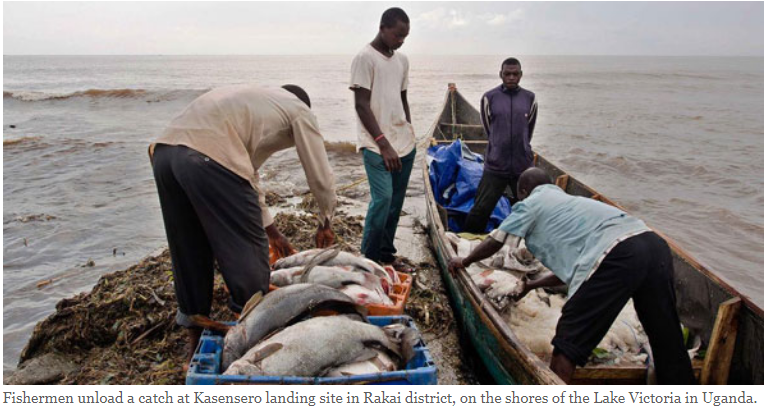Top fisheries scientists in a review of the main fish stock in the region have reported recovery of stock status of different species, notably the Nile perch, which forms the backbone of commercial fishing.
A 2017 survey on fish stocks in Lake Victoria shows that there is increased number of Nile perch species which contributes the biggest fraction of the total fish tonnage exported every year.
Three years back, information from NaFIRRI indicated that micro-organisms in the lake on which the young fish feed are also dying. This is brought about by the floating algae bloom on the lake that is poisoning the fish and cutting off oxygen supply to marine life.
But addressing a news conference at Uganda Media Center in Kampala, Anthony Taabu Munyaho, Director of National Fisheries Resources Research Institute (NaFIRRI) said that the increased number of Nile perch is attributed to the recent Uganda Peoples Defence Forces enforcement team that has been patrolling Lake Victoria against illegal fishing. Nile perch, which is the most commercially viable, should not be harvested until it is 50cm long, or weighing 2kg, regardless of its sources.
Uganda, which controls 45 per cent of Africa’s largest freshwater lake, has deployed the military to guard its territorial waters and keep foreigners away.

Dr. Tabu on Wednesday revealed that NaFIRRI in partnership with two sister institutes, Kenya Marine & Fisheries Research Institute (KMFRI) & Tanzania’s (TAFIRI) conduct on annual basis an independent stock monitoring survey in Lake Victoria.
“This survey lasts 30 consecutive days, where selected scientists from both countries traverse the entire lake, scanning and counting all the live fish under water using echo-Sounders mounter on a big research vessel,” Dr. Tabu said.
“The results compared to those of previous surveys of 1999-2016 are better,” he added. “I report a 30% increase in the quantity of Nile Perch relative to last year’s estimate.”
Fish processors across the countries have enforced this requirement by rejecting undersize and underweight fish. That, however, has not stopped the undersize fishing, as the fish find markets elsewhere, especially in DRC. Often, the fish is smoked and smuggled across in trucks.
“On a sad note however, the biomass of mukene (silver fish) has continued to decline in the last four years 2014-2017,” Dr. Tabu said.
The magical Nile Perch
The Nile perch (Latesniloticus) is a species of freshwater fish in the Latidae family of the order Perciformes. The
Nile perch can weigh up to 250kg with an average length of a mature fish averaging 121-137cm (48-54 inches), although many fish are caught before they can grow this large.
Though the introduction of the Nile perch was an ecological disaster that has led to the extinction of some of the indigenous fish species, it increased fish stocks in the lake 10 times, according to NaFFIRI.
The Nile perch was introduced along with two other tilapia species to boost the indigenous tilapia stocks in Lake Victoria which had declined.
According to scientists, the Nile Perch has the capacity to produce a lot of eggs, so populations can be sustained well if they increase in body weight. The heavier the fish, the more eggs it produces. A 50kg Nile perch produces 7 million eggs at a go, and it is capable of going through the cycle at least thrice a year.
Demand for fish had been on the rise since the late 1990s and Uganda, which on account of availability of a cheap labour force and highly prized varieties, Tilapia and Nile Perch, was cashing in on the comparative advantage it had over other fresh water fish producing countries.
In 1991, government banned export of unprocessed fish.
This led to growth of the establishment of fish processing units in Jinja, Kampala and Entebbe.
On the flipside, Nile perch stimulated the establishment of large fishing companies and boosted sport fishing tourism in the region, with Murchison Falls considered one of the best fishing destinations in the world.
Every year, anglers from all over the world converge here to hook out Nile perch, weigh the fish and take their pictures with the catch, before releasing them back into the water.

Though Uganda has an array of water bodies which contribute to the national fisheries sector, fish production data from other water bodies and swamps is largely unavailable. What is available pertains to production in the bigger water bodies like Lakes Victoria, Albert, Edward, Kyoga and River Nile.
According to figures from FAO, Nile Perch catches from Lake Victoria were way above the 100,000 tonnes per year mark during the period between 1980 and 1990. They had peaked at 130,000 tonnes in 1992, but dropped to between 80,000 and 90,000 tonnes between 1995 and 1997.
The drop in catches was attributed to among other things, over fishing and pollution of the water bodies, which had an adverse effect on exports.










